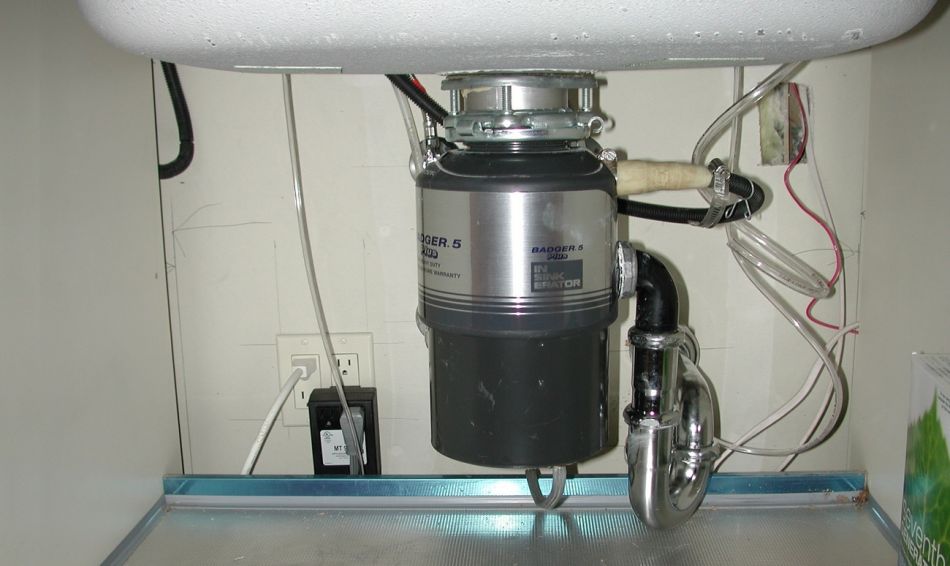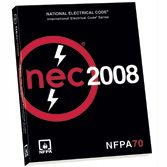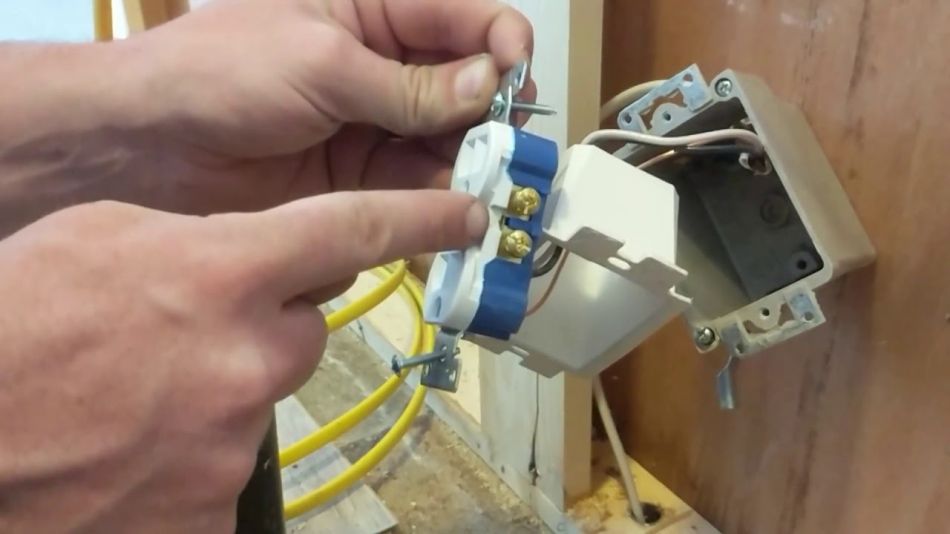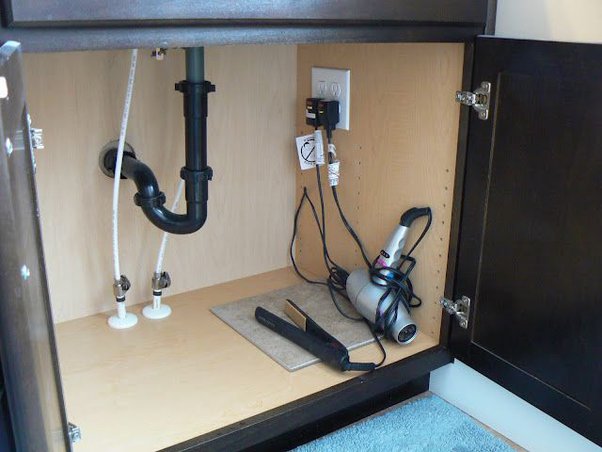Can You Put An Electrical Outlet Under A Sink?

If you are thinking about buying yourself a dishwasher or any similar type of kitchen appliance, for example, a garbage disposal unit, you should definitely consider installing an electrical outlet under your sink. This can help you conserve space and offer a great option to seamlessly include your appliance into the kitchen environment. There is only one problem with this solution, does the law allow it? In this article, we’ll talk about that. So, let’s start!
Can You Put An Electrical Outlet Under A Sink? Electrical outlets can be installed under a sink by National Electrical Code (NEC) regulations. However, each state has different building codes and laws, so be sure to contact the building code office in your hometown to see that they apply. A professional electrician is recommended for this job.
Local laws may dictate not only the placement of the outlet itself but also the type of the outlet and its protection. For example, if your garbage disposal unit draws power from this outlet, an outlet with GFCI protection might be required. For this reason, it’s important to check all the rules and regulations before installing the outlet. In the next sections, we’ll talk about that.
Code Regulations (NEC) About Outlets Under a Kitchen Sink

Even though the NEC (National Electric Code) is the main authority when it comes to electrical outlets, contacting the local authorities might still be the best option due to a number of reasons. First of all, the NEC does not explicitly mention electrical outlets located under sinks, nor does it state any additional information such as a GFCI protection requirement. Still, by referring to the code itself, we can notice that electrical outlets under sinks are not illegal.
Code Regulations (NEC) About GFCI Outlets In The Kitchen
Furthermore, by examining a section of the NEC called “Ground-Fault Circuit-Interrupter Protection” (section 210.8, sub-section (A)) does provide some info when it comes to GFCI outlet protection. The following locations require a GFCI protection implemented into the branch circuit:
- Places with high levels of moisture
- Basements
- Wet areas
- Kitchens
- Showers and bathtubs
- Sinks
- Crawlspaces
- Areas designated for laundry
- Bathrooms
- Outdoor areas
As we can see, GFCI protection is required when it comes to kitchen outlets. This is confirmed further in the code, with the explanation being that GFCI protection is required if the main purpose of the outlet is powering countertop kitchen appliances. Another requirement has to do with the distance between the outlet and the top edge of the sink.
The requirement states that GFCI protection is required if the outlet is installed by a range within 1.8 m from the top edge of the sink. As we have already mentioned, you should contact your local authorities and check if they have any additional requirements regarding electrical outlets under sinks.
If you want to learn more about electricity, be sure to read What To Do If Your Electrical Outlet Gets Wet?
How To Add Outlet Under the Sink?

There are two ways to go about this, but you should stick to the GFCI requirements before deciding which option you wish to go with. Either use something like the Wiremold NMW35, which is a surface mount box, or simply drill a hole into the wall where you wish to install your outlet and secure it with a stud mount.
Now, as we have already noticed while checking the NEC for GFCI requirements, each electrical outlet within 1.8 m (6 feet) from the sink should have GFCI protection. This is if we refer to The Spruce.
But, according to Jade Learning, this might not be the case anymore due to a number of changes made to the NEC, specifically concerning electrical outlets under sinks, which no longer require GFCI protection. This does not mean that you should immediately cross out this option since it offers an added level of safety, especially if, for example, the sink leaks.
Also, installing GFCI protection isn’t an issue and can be done almost the same way as you would install a regular electrical outlet. You will still need a metal conduit cable, more precisely a 2-conductor and a 12-gauge wire, and an electrical box.
How Far Should The Outlet Be From The Sink?
This is where it gets a little bit tricky since the NEC states only maximum and not minimum distances. The exact placements are also mentioned – below or next to, but in no case should it be opposite of the sink. Furthermore, the recommended distances stated for the kitchen and bathroom are within two feet and within three feet of the sink, respectively.
What Are GFCI Outlet Requirements by NEC?
Another issue arises when it comes to the NEC and GFCI outlets since the NEC states that a GFCI outlet needs to be installed in an easily accessible location, which the area under the sink definitely isn’t. Especially if it is installed on the back side of the drainpipes of the sink. Moreover, a GFCI outlet could pose a potential issue due to the fact that it should be tested and checked often to ensure that it still works as it should.
How Outlet Under The Sink Should Be Installed?
You may have also noticed that in some cases, the electrical outlet located under the sink is definitely closer and in the range of 6 feet when it comes to the distance between the outlet and from the top edge where the sink is located. To find out why we will once again refer to Section 210.8.
The Section states that the distance to the outlet will simply be measured by the following: the fastest path from the outlet to the kitchen appliance. The path that is followed is of course, the path of the supply cord connected to the kitchen appliance without it having to pass through a wall, ceiling, floor, window, or any fixed barrier.
To simplify, this would mean that each electrical outlet installed under a sink requires GFCI protection no matter the distance from the outlet to the actual top edge of the sink. This part of the section makes things more confusing and could be clarified better and easier.
We also recommend: What Is A Self-Grounding Outlet? (Explained)
Why Water and Electricity Don’t Mix?
Water and electricity is a highly dangerous combination that should be avoided at all costs when it comes to electrical devices, including electrical outlets.
This is because water works as a great conductor for electricity due to a high number of ions, which are atoms that carry either positive or negative electric charges due to an altered number of electrons.
The ions amplify the flow of electricity, which could lead to short circuits. Unnoticed short-circuits could result in fires and additional, unnecessary damage to your household. GFCI protection serves to annul this danger.
Professional View When Installing Outlets Under A Sink

As with all laws and codes, the NEC sparks debates and conversations, especially among the well-educated and professional circles. This is also the case with professional electricians.
View of Professional Plumber
Most professionals consider installing outlets under sinks only for devices such as dishwashers or garbage disposal units due to the hard accessibility of the outlet, meaning that it isn’t very useful when it comes to countertop appliances. In their opinion, installing an outlet under the sink shouldn’t pose a problem or safety issue as long as it is done properly. This is where GFCI outlets generally come in handy.
View of Building Code Inspectors
These are probably the best people to contact and ask for opinions since they are the ones who approve that your home follows the building code of the local authorities. Local building code inspectors are the ones who approve or disapprove your home by signing and giving you the building permit, and their views of the NEC are most definitely the most important ones.
View of Home Inspectors
Unlike electricians, home inspectors tend to follow the code and are definitely stricter about electric outlet placement. They will most certainly highlight the six-foot or 1.8m rule, stating that the area under the sink can be considered as an area with a high level of moisture. This demands the use of a GFCI outlet.
Can A Homeowner Install An Electrical Outlet Under A Sink?
Most definitely! That is if you know what you’re doing. Even though legally you are allowed to do this type of work, there are some things you should know or learn before starting this kind of project. First of all, by not knowing what you’re doing, you could cause damage to your house.
Second of all, you could hurt yourself in the process. For this reason, we have compiled a list below of all the things you should know and do if you decide to install an electrical outlet under your kitchen sink.
1. Preparation
Once again, we’ll highlight the importance of contacting your local officials to inform yourself whether you need a homeowner’s work permit and to introduce yourself to the local rules and regulations. Furthermore, having some prior knowledge of wiring or electrical work in general definitely won’t harm you. By carefully planning out what and how you want to deal with this job, you’ll save yourself from stress and unwanted issues.
2. Contact A Building Inspector
The easiest and, most likely, the best way of finding out about the local rules and regulations regarding building codes is to contact someone who is a professional in this field. In this case, the perfect person to contact would be a local building inspector, who will be happy to tell you everything about that. You’d be doing yourself a huge favor by speaking to a building inspector since they are the ones who are most familiar with the building codes.
3. Take Additional Factors Into Consideration
Depending on what is included in your project and your final goal, purely installing an electrical outlet might not be the end of the story.
For example, if you want to install a garbage disposal unit, you’ll have to do some additional work (installing a switch, connecting the outlet’s wiring and the newly added switch and electrical box). As we’ve already stated, plan everything before you’ve started the project.
Furthermore, connecting a new electrical outlet to the branch circuit might cause you additional issues. Be sure to check the building and electrical codes first because some of the codes might restrict the number of outlets you can connect to a branch circuit.
If this happens, you will most likely be forced to hire a professional electrician since the solution to this issue includes adding a branch circuit that is new and a circuit breaker.
4. Conclusion
Although installing an electrical outlet under the sink doesn’t sound like that big of a project, for homeowners with no prior knowledge or experience when it comes to electrical installations, this project could simply be too complicated.
Especially if it involves installing a garbage disposal unit, for example. The best thing to do is contact a professional or someone with experience who can either guide you or do the work for you. Either way, be careful with electrical installations and don’t take these types of projects lightly as they can cause major damage if installed poorly.
Do Kitchen Outlets Need to be Replaced With GFCI?
This rule applies only if you are upgrading, adding, or simply fixing anything connected to the electrical installations in your home. If your home adhered to the building codes of the time, you most likely don’t have to make any changes to your existing installations.
Furthermore, even if having something like a GFCI outlet isn’t a legal requirement, installing it, either way, won’t do any harm. Quite the opposite, it will ensure your safety. This especially applies to areas with high moisture levels that are prone to water leaks or splashing.
Final Thoughts
Even though the NEC does state some ground rules for installing electrical outlets under sinks, your local authority has probably adapted, changed, and added some of its own regulations to the NEC. For this reason, the best thing to do is contact your local authorities and find out which requirements need to be met when installing your electrical outlet.
Furthermore, even if the project seems like a piece of cake, hiring a professional might not be such a bad idea. Even though it will probably cost more money, at least you will be certain that the installations were done properly and, most importantly, won’t cause any harm due to poor construction.
